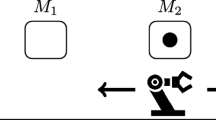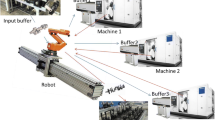Abstract
In this paper, we deal with the problem of sequencing parts and robot moves in a robotic cell where the robot is used to feed machines in the cell. The robotic cell, which produces a set of parts of the same or different types, is a flow-line manufacturing system. Our objective is to maximize the long-run average throughput of the system subject to the constraint that the parts are to be produced in proportion of their demand. The cycle time formulas are developed and analyzed for this purpose for cells producing a single part type using two or three machines. A state space approach is used to address the problem. Both necessary and sufficient conditions are obtained for various cycles to be optimal. Finally, in the case of many part types, the problem of scheduling parts for a specific sequence of robot moves in a two machine cell is formulated as a solvable case of the traveling salesman problem.
Similar content being viewed by others
References
Asfahl, C.R.,Robots and Manufacturing Automation, John Wiley & Sons, New York, NY (1985).
Atallah, M.J., and Kosaraju, S.R., “Efficient Solutions to Some Transportation Problems with Application to Minimizing Robot Arm Travel,”SIAM Journal on Computing, Vol. 17, No. 5, pp. 849–869 (1988).
Baumann, W., Birner, R. Haensler, J., Hartmann, R.P., and Stevens, A.G., “Operating and Idle Times for Cyclic Multi-Machine Servicing,”The Industrial Robot, pp. 44–49 (March 1981).
Bedini, R., Lisini, G.G., and Sterpos, P., “Optimal Programming of Working Cycles for Industrial Robots,”Journal of Mechanical Design, Transactions of the ASME, Vol. 101, pp. 250–257 (1979).
Blazewicz, J., Sethi, S.P., and Sriskandarajah, C., “Scheduling of Robot Moves and Parts in a Robotic Cell,” InProceedings of the third ORSA/TIMS Conference on Flexible Manufacturing Systems: Operations Research Models and Applications, (Ann Arbor, MI) K.E. Stecke and R. Suri (Eds.) Elsevier Science Publishers B.V., Amsterdam, The Netherlands, pp. 281–286 (1989).
Claybourne, B.H., “Scheduling Robots in Flexible Manufacturing Cells,”CME Automation, Vol. 30, No. 5, pp. 36–40 (1983).
Cohen, G., Dubois, D., Quadrat, J.P., and Viot, M., “A Linear-System-Theoretic View of Discrete-Event Processes and Its Use for Performance Evaluation in Manufacturing,”IEEE Transactions on Automatic Control, Vol. AC-30, pp. 210–220 (1985).
Cunninghame-Greene, R.A.,A Minimax Algebra, Springer-Verlag, New York, NY (1979).
Devedzic, V., “A Knowledge-Based System for the Strategic Control Level of Robots in Flexible Manufacturing Cell,”International Journal of Flexible Manufacturing Systems, Vol. 2, No. 4, pp. 263–287 (July 1990).
Dixon, C., and Hill, S.D., “Work-cell Cycle-time Analysis in a Flexible Manufacturing System,”Proceedings of the Pacific Conference in Manufacturing, Sydney and Melbourne, Australia, Vol. 1, pp. 182–189, (December 17–21, 1990).
Drezner, Z., and Nof, S.Y., “Optimal Bin Picking and Insertion Plans for Assembly Robots,”IIE Transactions, Vol. 16, No. 3, pp. 262–270, (1984).
Dubois, D., Sethi, S.P., and Stecke, K., “A Petri Net Formulation of a Flexible Manufacturing Systems,”ORSA/TIMS, Orlando, Florida (November 7–9, 1984).
Dubois, D., and Stecke, K., “Dynamic Analyses of Repetitive Decision-Free Discrete-Event Processes: Application to Production Systems,”Annals of Operations Research, Vol. 26, pp. 323–347 (1990).
Gilmore, P., and Gomory, R. “Sequencing a One-State Variable Machine: A Solvable Case of the Traveling Salesman Problem,”Operations Research, Vol. 12, pp. 655–679 (1964).
Hall, R.W., “Cyclic Scheduling for Improvement,”International Journal of Production Research, Vol. 26, No. 3, pp. 457–472 (1988).
Hitomi, K., and Yoshimura, M., “Operations Scheduling for Work Transportation by Industrial Robots in Automated Manufacturing Systems,” InRobotics and Material Flow, S.Y. Nof (Ed.), Elsevier Science Publishers, New York, NY, pp. 131–139 (1986).
Howie, P., “Graphic Simulation of Off-Line Robot Programming,”Robotics Today, Vol. 6, No. 1, pp. 63–66 (1984).
Kim, C.E., and Langston, M.A., “Movement Coordination for Single-Track Robot Systems,”Journal of Robotic Systems, Vol. 4, No. 1, pp. 49–62 (1987).
Kondoleon, A.S., “Cycle Time Analysis of Robot Assembly Systems,”Proceedings of the Ninth Symposium on Industrial Robots, pp. 575–587 (March 1979).
Maimon, O.Z., and Nof, S.Y., “Coordination of Robots Sharing Assembly Tasks,”Journal of Dynamic Systems Measurement and Control, Transactions of the ASME, Vol. 107, No. 4, pp. 299–307 (December 1985).
Nof, S.Y., and Hanna, D., “Operational Characteristics of Multi-Robot Systems with Cooperation,”International Journal of Production Research, Vol. 27, No. 3, pp. 477–492 (1989).
Rabinowitz, G., Mehrez, A., and Samaddar, S., “A Scheduling Model for Multirobot Assembly Cells,”International Journal of Flexible Manufacturing Systems, Vol. 3, No. 2, pp. 149–180, (1991).
Sarin, S.C., “Mathematical Analysis of a Robotized Production Cell,”INFOR, Vol. 25, No. 1, pp. 46–56 (1987).
Seidmann, A., and Nof, S.Y., “Oprational Analysis of an Autonomous Assembly Robotic Station,”IEEE Transactions on Robotics and Automation, Vol. 5, No. 1, pp. 4–15 (1989).
Seidmann, A., Schweitzer, J.P., and Nof, S.Y., “Performance Evaluation of a Flexible Manufacturing Cell with Random Multiproduct Feedback Flow,”International Journal of Production Research, Vol. 23, No. 6, pp. 1171–1184 (1985).
Stauffer, R.N., “Robot System Simulation,”Robotics Today, Vol. 6, No. 3, pp. 81–90 (1984).
Wilhelm, W.E., “Complexity of Sequencing Tasks in Assembly Cells Attended by One or Two Robots,”Naval Research Logistics, Vol. 34, pp. 721–738 (1987).
Wilhelm, W.E., and Sarin, S.C. “A Structure for Sequencing Robot Activities in Machine Loading Applications,”International Journal of Production Research, Vol. 23, No. 1, pp. 47–64 (1985).
Wittrock, R.J., “Scheduling Algorithms for Flexible Flow Lines,”IBM Journal of Research and Development, Vol. 29, No. 4, pp. 401–412 (1985).
Author information
Authors and Affiliations
Rights and permissions
About this article
Cite this article
Sethi, S.P., Sriskandarajah, C., Sorger, G. et al. Sequencing of parts and robot moves in a robotic cell. Int J Flex Manuf Syst 4, 331–358 (1992). https://doi.org/10.1007/BF01324886
Issue Date:
DOI: https://doi.org/10.1007/BF01324886




